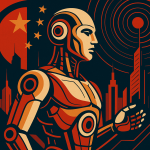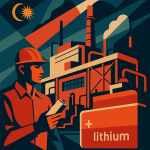“`html
Key Points
- China’s new ‘AI+’ initiative, announced on July 31, 2025, by Premier Li Qiang, signals a significant top-down push to embed AI across its economy and society.
- The core goal is the massive, real-world deployment and deep integration of AI across all sectors, promoting a cycle where innovation drives application and vice-versa.
- The government plans to make ‘AI+’ a reality by mandating government departments and SOEs to lead AI adoption and strengthening the AI ecosystem’s three core pillars: computing power, algorithms, and data supply.
- The initiative is part of a broader economic strategy, announced alongside policies like loan subsidies to stimulate spending and a new law to protect farmland, highlighting a holistic approach to national security and development.
- Key takeaways indicate that the government is the ultimate customer for B2B AI startups, massive investment will flow into AI infrastructure, and companies need to adapt to a rapidly evolving regulatory landscape for AI governance and safety.

China’s new ‘AI+’ initiative is officially a go, marking one of the most significant top-down pushes for artificial intelligence integration we’ve seen yet.
On July 31, 2025, China’s Premier Li Qiang led a State Council executive meeting that laid out a bold new vision.
This isn’t just another policy paper.
It’s a clear signal that Beijing is moving to embed AI into every corner of its economy and society.
So, what exactly did they decide, and what does it mean for investors, founders, and the global tech scene?
Let’s break it down.
The ‘AI+’ Initiative: Moving Beyond Hype to Mass Adoption
The core of the announcement was the approval of the “Opinions on Deeply Implementing the ‘Artificial Intelligence+’ Initiative.”
Forget beta tests and pilot programs. The goal here is massive, real-world deployment.
The initiative is built on three key pillars:
- Promote large-scale commercial application of AI.
- Accelerate the deep integration of AI across all sectors of the economy and society.
- Create a virtuous cycle where innovation drives application, and in turn, application promotes more innovation.
How China Plans to Make ‘AI+’ a Reality
This isn’t just wishful thinking; there’s a concrete playbook to make it happen:
- Lead by Example: Government departments and state-owned enterprises (SOEs) are being mandated to take the lead. They will open up more “application scenarios” to drive AI adoption from the top down. This is a huge market signal.
- Build the AI Ecosystem: A major focus is on strengthening the three core pillars of AI development:
- Computing Power
- Algorithms
- Data Supply
- Policy and Talent: Expect increased policy support, a bigger push for talent development, and the construction of an “open-source and open system” to fuel industry growth.
- Governance and Safety: Alongside this massive push, there’s a clear mandate to improve safety capabilities. Beijing is aiming to build a “dynamic, agile, and multi-faceted AI governance framework.” This is a critical point for any company operating in the space.

Resume Captain
Your AI Career Toolkit:
- AI Resume Optimization
- Custom Cover Letters
- LinkedIn Profile Boost
- Interview Question Prep
- Salary Negotiation Agent

It’s Not Just About AI: The Broader Economic Playbook
The ‘AI+’ initiative didn’t happen in a vacuum.
It was part of a larger meeting focused on stabilizing and stimulating China’s economy, following directives from General Secretary Xi Jinping.
The government is laser-focused on overcoming challenges and ensuring the positive economic recovery trend continues.
Two other major policies were announced that provide crucial context.
1. Stimulating Spending with Loan Subsidies
To juice the economy, the State Council rolled out a new policy for interest subsidies.
This will impact two key groups:
- Individual consumption loans
- Loans for service industry businesses
The goal is simple: use a combination of fiscal and financial tools to “reduce credit costs for residents and financing costs for service industry businesses.”
By making it cheaper to borrow, the government aims to unlock consumer spending potential and boost market vitality.
They also emphasized strict oversight to make sure the money is used efficiently.
- Individual Consumption Loans: Aimed at stimulating consumer spending.
- Loans for Service Industry Businesses: Designed to boost vitality in this critical sector.
2. Getting Back to Basics: Protecting Farmland
In a move that underscores a focus on foundational security, the meeting also approved the “Draft Law of the People’s Republic of China on Farmland Protection and Quality Enhancement.”
This isn’t just about farming; it’s about national security.
The law stresses an integrated protection model covering:
- Quantity: Ensuring there is enough farmland.
- Quality: Making sure the land is productive.
- Ecology: Protecting the long-term environmental health of the land.
This highlights a holistic approach to national strategy—you can’t have a high-tech revolution without ensuring food and resource security.

Key Takeaways for Founders, Investors, and Techies
So, what are the actionable insights from this high-level meeting?
- The Government is the Ultimate Customer: The directive for government bodies and SOEs to open application scenarios means the state will be the single biggest driver of AI adoption. For B2B AI startups, this is the market to watch.
- Infrastructure is Everything: The explicit mention of computing power, algorithms, and data is a green light for companies in the AI infrastructure space. From chip designers to data labeling services, this is where massive investment will flow.
- Governance is Coming, Fast: China’s push for an “agile” and “multi-faceted AI governance framework” means the regulatory landscape will evolve rapidly. Companies need to stay ahead of compliance and safety standards.
- A Holistic Strategy: The AI push is happening alongside consumer stimulus and agricultural protection. This shows a government trying to create a stable, solid foundation upon which its tech ambitions can be built. They’re trying to de-risk the entire system.

Find Top Talent on China's Leading Networks
- Post Across China's Job Sites from $299 / role, or
- Hire Our Recruiting Pros from $799 / role
- Qualified Candidate Bundles
- Lower Hiring Costs by 80%+
- Expert Team Since 2014
Your First Job Post

The Bottom Line: A Bold New Chapter for Chinese Tech
The State Council’s meeting on July 31, 2025, wasn’t just another bureaucratic session.
It was a declaration of intent.
By pairing a massive, top-down AI deployment strategy with targeted economic stimulus and foundational security policies, China is laying out a comprehensive roadmap for its future.
The China AI+ initiative is more than just a policy; it’s a clear and powerful vision for a future where artificial intelligence is woven into the very fabric of the country’s economy and society.

ExpatInvest China
Grow Your RMB in China:
- Invest Your RMB Locally
- Buy & Sell Online in CN¥
- No Lock-In Periods
- English Service & Data
- Start with Only ¥1,000

References
- State Council Executive Meeting Approves Opinions on Deep Implementation of the “AI+” Initiative – Eastmoney Finance
- China to Unleash AI for Nationwide Transformation – XinhuaNet
- Premier Li Qiang Presides Over Executive Meeting of the State Council – Ministry of Foreign Affairs of the People’s Republic of China
“`





